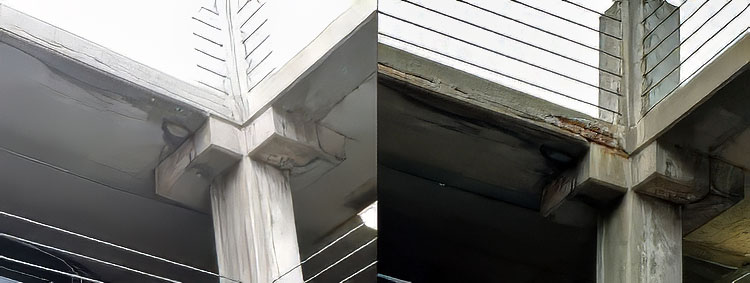Facade inspection laws (also referred to as exterior wall inspection laws) exist to protect public safety and extend the life of a building’s exterior. New York City was a pioneer in this area, enacting the first facade inspection law in 1980 (Local Law 10/1980). This came in response to several high-profile incidents in the late 1970s, where debris from deteriorated building exteriors posed significant risks to pedestrians and surrounding properties.
Relationship Between Facade Inspection Laws and Parking Garage Regulations
While facade ordinances focus on the maintenance and safety of buildings’ exterior envelopes, they apply to parking garages only if the garages meet specific criteria—typically related to height and age.
In some jurisdictions, parking garages are regulated under separate inspection laws. These laws address structural integrity and require both the exterior AND interior of the parking garage to be inspected. For further details on parking garage inspection laws, see “Parking Garage Laws in the US (StructureCare).“
Jurisdictional Overview
The table below summarizes facade ordinances in several major U.S. jurisdictions.
Jurisdiction
Parking Garage Law?
Link to Ordinance
Age Requirement
Height Requirement
Inspection Frequency
Year Effective
Chicago, IL
No
Any
> 80 ft
Ongoing (2 years); Additional (for critical conditions at 4, 8, or 12 years)
1996
1Columbus, OH: In lieu of a height requirement, the ordinance states: “…requirements shall apply to each building that is (1) 20 years old or older; and (2) Located within ten feet of a public right-of-way…”
2Boston, MA: 5 years for occupied structures, annually for unoccupied structures (Sec 9-9.12.b)
Who Is Affected?
These ordinances typically target mid-to-high-rise buildings, generally defined as those exceeding five or six stories. Many cities also include an age threshold; for instance, Cleveland’s ordinance applies to buildings that are at least 30 years old. Additionally, some jurisdictions (such as Pittsburgh) exempt specific building types, including certain residential uses. Building owners should verify whether their structure meets the specific criteria of their local ordinance.
Inspection Requirements
Frequency & Scheduling:
While a 5-year cycle is common, some cities adopt risk-based schedules. For example, Chicago requires ongoing inspections for certain buildings every 2 years, with additional critical examinations at 4, 8, or 12-year intervals depending on facade classification. Milwaukee also employs a variable inspection schedule based on facade category, requiring inspections every 5, 8, or 12 years.
Methodology:
Inspections generally involve both visual assessments and more detailed evaluations, following standards such as ASTM E2270. This standard outlines procedures for identifying unsafe conditions in building facades.
Qualified Inspectors:
Inspections must be performed and/or supervised by licensed professionals, typically a Professional Engineer (PE) or Registered Architect (RA), to ensure compliance with local codes and safety standards. Some jurisdictions may require specific qualifications beyond state licensing.
Enforcement and Penalties
Enforcement and penalties vary widely by jurisdiction. For example, New York City imposes strict fines for noncompliance—up to $1,000 per month and $5,000 per year until remedial work is completed. In contrast, other cities have less clearly defined penalties or different enforcement mechanisms. Building owners should carefully review their local ordinances to ensure compliance and avoid costly fines.
The Importance of Proactive Maintenance
Public Safety:
A single loose piece of masonry can pose a severe hazard to pedestrians and property. Regular inspections allow early detection and repair of deterioration, reducing the risk of accidents and costly damage.
Financial Implications:
Non-compliance can result in steep fines and, over time, higher repair costs. Staying current with inspections and maintenance can save money and reduce liability.
Preservation of Property Value:
A well-maintained facade enhances curb appeal and market value while reducing overall liability risks.
Visual Example: Deferred Maintenance

Left: Cracked concrete at a slab edge. Right: The same area three years later, showing advanced deterioration due to deferred maintenance. Inaction allows deterioration mechanisms to continue and ultimately increases repair costs.
Understanding and complying with facade inspection laws is essential for building and parking garage owners who want to maintain safety, prevent costly fines, and preserve property value. Staying informed about local facade inspection laws ensures your structure remains compliant, and your occupants stay protected.
About the Author: Nick Heim, P.E.

Nick’s interests lie at the intersection between the built world and technology, and he can be found looking for the ever-changing answer to the question, “How can we do this better?” Nick can be found on LinkedIn, producing content about the use of technologies in his civil engineering career and small business.






